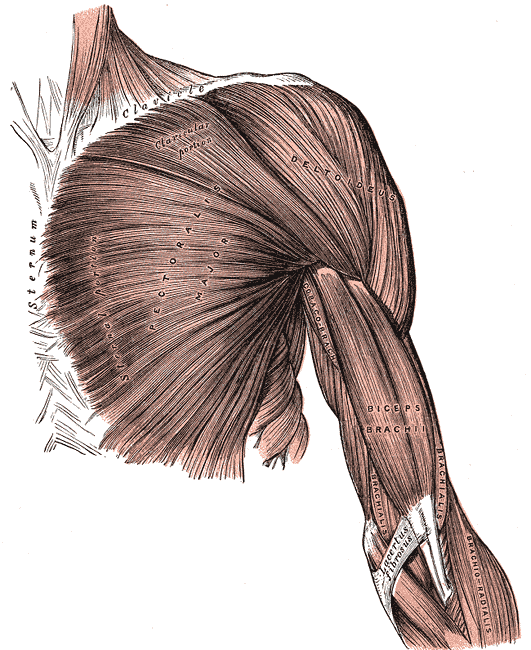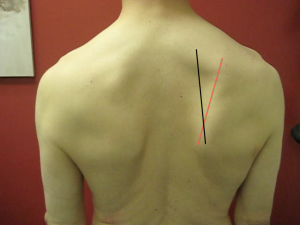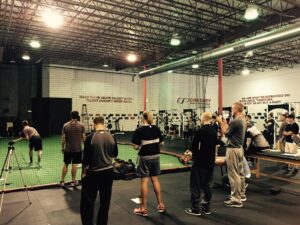
Checks and Balances in the Shoulder of the Throwing Athlete
For today’s guest post, I’ve collaborated with physical therapist Eric Schoenberg, who heads up physical therapy at our Cressey Sports Performance – Florida location. Enjoy! -EC
The #1 reason why a player or team does not succeed in baseball is injury. Today, there is a surplus of information, but at the same time a lack of basic understanding of how to keep a baseball player healthy. When in doubt, you can never go wrong by understanding and relying upon anatomy and quality human movement.
One key principle to understand in this regard is that there is a tremendous system of checks and balances working at the shoulder girdle to make sure that we control both the big movements (osteokinematics) and subtle joint movements (arthrokinematics) in a small window for health and performance. If we look to anatomy, we can appreciate a very important concept by looking at the attachment points for the deltoid, latissimus dorsi, and pectoralist major: your three biggest prime movers in the upper extremity. You’ll notice that all three attach on the shaft of the humerus, not the humeral head. Take a look at their attachment sites on this anatomical chart, and then compare them to where the rotator cuff (supraspinatus, subscapularis, teres major, and teres minor) attach further up on the humeral head.
Source: https://howtorelief.com/humerus-anatomy-bony-landmarks-muscle-attachment/
You can appreciate that all these big muscles attach on the anterior (front) aspect of the humerus, which means that they have powerful pulls into internal rotation that have to be counteracted by fewer, smaller muscles that attach on the posterior (back) aspect of the shoulder.
Here are three specific implications of these anatomical observations that relate to how you manage your throwing athletes:
1. The Deltoid is strong/active enough!
The deltoid works in conjunction with the supraspinatus to form a “force couple.”
Source: www.MikeReinold.com
If the strength, recruitment, or timing of the deltoid is greater than the supraspinatus, then the result will be superior migration of the humeral head in the glenoid. This results in superior humeral head stress (chondral defect), undersurface rotator cuff tear, labral pathology, among other structural injuries to the glenohumeral joint.
Tip: Be sure that athletes feel rotator cuff strengthening exercises in the cuff and not the deltoid or biceps.
2. The lat is strong/active enough!
The lat (as it acts on the scapula) is opposed by the serratus anterior, lower trapezius, and upper trapezius to control scapular rotation. Increased relative stiffness of the lat results in excessive scapular depression and downward rotation at rest.

Additionally, if you have decreased activation or muscle performance of the scapular upward rotators and elevators with overhead motion, the outcome will be inferior migration of the glenoid on the humeral head.
This results in superior humeral head stress (chondral defect), undersurface rotator cuff tear, labral pathology, among other structural injuries to the glenohumeral joint.
Tip: Be sure that the athlete’s programs have a good balance of overhead reaching tasks done with proper mechanics and timing of the glenohumeral and scapulothoracic joints.
3. The pecs are strong/active enough!
Pectoralis major’s impact on the anterior glenohumeral joint is opposed by the rotator cuff to prevent anterior humeral glide. Effectively, the pec and lats want to pull the ball forward on the socket as the arm goes through gross movements, and the rotator cuff works hard to prevent this gliding at the joint level.
Dominance of pec major over the rotator cuff muscles (namely subscapularis) will play a role in an athlete presenting with anterior humeral glide. We often hear the athlete report “tightness” in the front of the shoulder and their first option is to “stretch it.”
This can lead to anterior shoulder pain and potential structural pathology including anterior joint laxity, biceps tendon pathology, and labral pathology – all common injuries in throwing athletes.
Tip: Rather than trying to decrease the “tightness” in the front of the shoulder by aggressively stretching—instead, focus on improving static alignment, proprioceptive awareness, and recruitment of the cuff. If you couple this with some self-massage work, this approach will yield far more favorable results.
In closing, the shoulder joint is happiest when alignment is optimal. Injury will occur if preferred alignment is altered. Examples of altered alignment at rest or with movement are the humeral head is riding too high in the socket, the socket is riding too low on the humeral head, or the humerus is gliding too far forward. The resultant stress to the active or passive restraints of the shoulder leads to injury and loss of playing time. Do yourself (and the players that you work with) a favor and master the basics to help improve success on the field.
Looking to learn more about our unique approach to assessing and managing throwing athletes? Keep an eye out for the next offering of our Elite Baseball Mentorship Upper Extremity Course.
About the Co-Author
Eric Schoenberg (@csp_physicaltherapy) is a physical therapist located in Palm Beach Gardens, FL where he is owner of Diamond Physical Therapy, which operates out of Cressey Sports Performance – Florida. Eric treats extensively in the baseball community as part of the CSP team, and plays a part in the Elite Baseball Mentorship Seminars at Cressey Sports Performance. He can be reached at eric@diamondphysicaltherapy.com.






